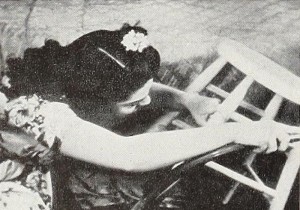
"Fire from the Skies should be a ringing challenge to amateur movie clubs and individual personal filmers across the country. For it is a competent, compelling and altogether mature contribution to the cause of civilian defense. It was produced by the Long Beach Cinema Club with no more facilities than are available to all of us. The added ingredient which put the production over was interest; they wanted to do it — and did ! The dynamic leadership of Mrs. Mildred J. Caldwell, ACL, former club president and coordinator of the present film, is felt throughout its footage. Telling a story of incendiary bomb protection, the picture tells it from the woman's angle, that of the housewife who, before all others, must fight to protect her home. The film employs shrewdly every artifice of the motion picture craft — color, sound, music, narrative and special effects. All are handled crisply and with confidence. The continuity is dramatic but informative, the camera work effective and the sound track exciting in its contribution to the visual message. Fire from the Skies need offer no apologies amid the too small company of America's civilian defense motion pictures." Movie Makers, Dec. 1942, 506.
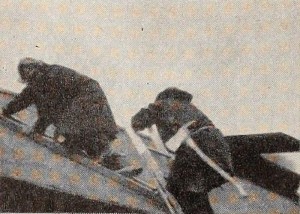
"In making Fire-Fighters Field Day, William Messner again has demonstrated his versatility with the motion picture camera. Choosing a subject which has only limited appeal, he makes it interesting nevertheless with good newsreel technique. Shooting the fire-fighting demonstration at New Haven, Connecticut, in one day's time and without advance planning, Mr. Messner captures the activities of the fire-fighters against a varied backdrop of flames, smoke, chemicals and steam. Since part of the action takes place in bright sunlight and part in shadow, the producer had to be alert in changing his diaphragm openings to insure even exposure. In view of the difficult and ever-changing light conditions, Mr. Messner deserves special commendation for the fidelity of his coverage. While the photography was outstanding, the accompanying tape track was a trifle noisy." Movie Makers, Dec. 1952, 340.
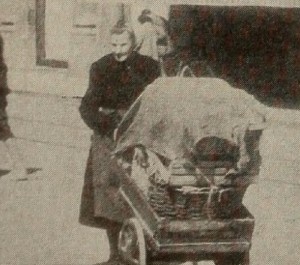
"Oscar H. Horovitz, in Firenze, Queen of the Arts, has once again produced an excellent record of a city, turning this time to Firenze (Florence), the Tuscan capital of the Italian Renaissance. Firenze is a monochromatic city of varying tones of brown, but a most attractive one as Mr. Horovitz has shown, existing today just as it did during the 16th Century. Belying the film's title, however, the many art treasures for which this city is justly famed are ignored, the filmer desiring apparently to show Firenze through an architectural eye. The film is, nevertheless, interesting, with lively pace and plenty of human interest. Here is a rewarding excursion to one of the fabulous cities of our time." Movie Makers, Dec. 1953, 334.
"The First Christmas Gift is a 'first film'. It was made over a week-end, only two hundred feet of film were exposed to make a two hundred foot picture. This was part of the problem, for the film was a bit of 'home work' in the University course being pursued by the producer. Christmas actually having passed, it was necessary for the producer to manufacture the small Christmas tree used for atmosphere, and so also, the snow on the lady's coat was improvised from materials found at home on a Sunday" ("Program Notes," 1940).
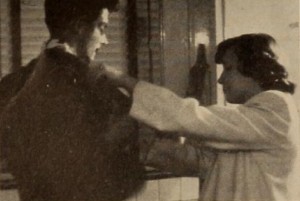
"The trials, tribulations and eventual triumphs of a teen aged young man embarked on his initial evening engagement are engagingly portrayed by John C. Sherard in First Date. Even the traditional nuisance role played by junior members of the girl's family is given a new angle — a trained flea circus on the loose. But this bit of business and others in a basically imaginative comedy are, on occasion, drawn out too much for the best dramatic pace. Outstanding in the film, however, is Mr. Sherard's use of Type A Kodachrome outdoors without the corrective filter to simulate moonlight." Movie Makers, Dec. 1949, 469.
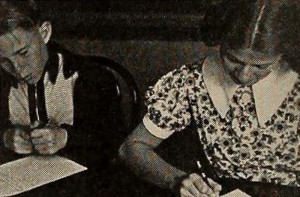
"First Film and When the Cat's Away, a double header entry, which takes honors jointly because of the strong relationship between the two, is the production of the Cinema Club of Lowell Junior High School, at Long Beach. Calif., and of the club's faculty adviser, Helen Rees Clifford. First Film, largely the work of Miss Clifford, summarizes the Junior High School group's experiences in producing When the Cat's Away, which is entirely the achievement of the youngsters. Together, the two films present a clear and concise picture of the initial production of a film by a junior high school movie club, from scenario writing and movie planning to the completed opus, ready for its premiere. So, in these two reels, one sees how the job of teaching movie making technique to youngsters, of ages from eleven to fourteen, can be handled efficiently and happily, and one learns how clear and coherent a little picture can be produced as a starter. Few high school photoplay clubs have begun so well and with so little lost motion. Very few high school first films are as clear and competent as When the Cat's Away." Movie Makers, Dec. 1938, 618.
"Walt MacDonald, proud father of his one year old, has designed a special birthday cake for his son and invited friends. One might ask why a parent should contribute so much time and energy just for the few minutes it takes small fry to undo it all. There are, of course, laughs as junior learns from experience in the lighter vein. A delightful birthday party to be enjoyed again and again, even by junior when he becomes senior" PSA Journal, Nov. 1958, 47.
"Grandpa has problems when he retires." Oldfilm.org
Total Pages: 299